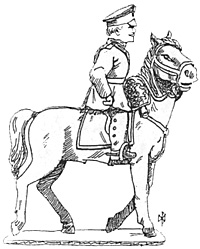
(The following is a narrative of a solo battle fought using the scenario and rules described in part 1.)
General Freiderich von Bulow sat atop his horse under the shade of an oak tree. Looking out across the Belgian landscape through his telescope he noted the church steeple in the midst of a cluster of houses.
“Is that? What’s that name? Plance something.”
Major Tomas Huber, his adjutant, said, “Plancenoit, my general. It appears to be the just short of the French positions.”
“Yes, our destination this afternoon,” replied the general.
As Bulow and his staff pored over a single map, a lone rider came galloping up. Bulow looked up and cursed silently. Von Gneisenau, Blucher’s over zealous and self-important staff officer. “Yes, Gneisenau, what can I do for you?” Bulow asked, hardly hiding his annoyance at the interruption. As the general staff officer pulled up, he saluted smartly. “Sir, General Blucher sends his regards and asks how your attack is coming.”
“My attack?” responded von Bulow. “I have only two brigades here with me. The other two are slogging through the waterlogged Belgian trails which our cartographers have elevated to the status of roads. It will be hours before I am ready to attack.” Von Bulow put his telescope once more to his eye signaling that the conversation was over.
But von Gneisenau would not let the pompous aristocrat off so easily. “My general. General von Blucher intends that you push forward as rapidly as possible to put pressure upon the flank of Napoleon’s army in order to relieve pressure on the English forces. As you do so, the First Corps will join Wellington on his left and strengthen the English position.” His voice grew more emphatic. “My general, you should move immediately.”
The corps commander’s staff involuntarily shuddered at the tactless order given to their general. Von Bulow himself was spitting angry but he knew from experience that von Gneisenau was relating his commander’s intentions faithfully if undiplomatically. “Colonel von Gneisenau” said Bulow, “You yourself can see from this map that there are few roads approaching Plancenoit.” He was delighted that he remembered the name of this collection of Belgian shanties. “How will I get there with enough force to accomplish my orders? The roads are mere sunken mud lanes and the Paris Forest lies in my way. If there are Frenchmen in the woods, my corps will be in great peril.”
Von Gneisenau changed his tone. He understood, mistakenly, this rhetorical question to be a genuine solicitation of his professional views. “General von Bulow.” He responded. “Your concerns are valid and I assure you that Blucher understands the great risk attendant to your movements. Nonetheless, he directs that you move forward rapidly along many routes. Your columns may move out of supporting distance, this is true. But the Frenchies can not guard all paths. While some columns may be stymied, others will emerge unscathed. Von Blucher expects you to attack the flank of Napoleon’s forces as quickly as possible with as much force as you can muster. A brigade attack in an hour will be more effective than a corps attack in three hours. If I may say so, General von Blucher is very much concerned that Wellington will be defeated and withdraw while our four corps are strung out between Wavre and Belle Alliance. He desires that Napoleon feel our presence at his rear quickly. This may prompt him to divide his forces between us and Wellington.”
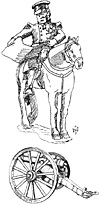 Von Bulow, for the first time in two days, finally understood Blucher’s intentions. “Danke, Oberst von Gneisenau,” he said, almost apologetically. “Tell General von Blucher that the Fourth Corps will move immediately with two brigades upon Plancenoit and will launch an attack as soon as physically possible. Tell our general that he can count on the Fourth Corps to do its duty.” Smiling faintly, von Gneisenau saluted crisply and turning about, whipped his horse into a gallop back the way he came.
Von Bulow, for the first time in two days, finally understood Blucher’s intentions. “Danke, Oberst von Gneisenau,” he said, almost apologetically. “Tell General von Blucher that the Fourth Corps will move immediately with two brigades upon Plancenoit and will launch an attack as soon as physically possible. Tell our general that he can count on the Fourth Corps to do its duty.” Smiling faintly, von Gneisenau saluted crisply and turning about, whipped his horse into a gallop back the way he came.
“Huber, get my brigade commanders, Kautt and Knapp, up here immediately! And Oberst Gabel, my cavalry commander. He is close by. Send for him as well.”
While Huber dispatched couriers to find and return with the three colonels, von Bulow examined the map. There appeared to be two roads leading directly into Plancenoit, one on either side of the Bois de Paris and both north of the flooded Lasne Brook. The Prussian general shook his head slowly from side to side. The terrain was dangerous in the extreme. The roads were swallowed up by low hills and small woods. There were dozens of points where a concealed battalion could stop a brigade. Cavalry would be next to useless, except perhaps to discover ambushes by running in to them. Fields of fire would be narrow and restricted. Nowhere could artillery stand off out of range and lend support to an attack. But he understood that his best security was in moving quickly, before the French could react. He looked up and openly cursed. Hundreds of his infantry were gathered about on this plateau, easily in view of the French. The French knew where he was and what his next move would be. He cursed again.
Author’s Note
This solo battle is a “what if” scenario. What if the Prussians had started toward Plancenoit a few hours early and what if Napoleon had sent forces to dispute the Prussian advance east of Plancenoit. The fight would be between well concealed French forces firing out of woods against the heads of thin columns of slow-moving infantry. As described in LW 147, I played the Prussians while automating the French. Each turn I rolled to see if a French force would enter the board. If so, I rolled to see the size and composition of the force and the location. If the location (I call them check points) had previously been cleared by the Prussians, then the French could not enter there but would enter in the vicinity of Plancenoit. The faster the Prussians could move, the earlier they would clear checkpoints, and the French would enter in less advantageous positions. This was really a new concept of a game for me and, as it turned out, a pretty rousing and surprising endeavor all the way around. Now, back to the corps commander’s orders group.
Bulow Issues his Orders
As soon as his subordinates arrived, von Bulow issued his orders. “Listen carefully. We are moving on Plancenoit immediately. Our goal is to put pressure on Napoleon’s flank. This will cause him to fight in two directions at once. If we move fast enough and strike with enough strength, then the English will remain on the field. If not, then our Prussian Army will be caught strung out over many miles and defeated in detail.”
His two brigade commanders looked at one another. Then General von Kautt blurted out what everyone was thinking. “Sir. Do you mean move right now? Part of my brigade is not yet here and the rest of the corps is still between here and Wavre.” “Yes, I understand,” responded von Bulow. “But speed is important. If Napoleon receives reports as we assault Plancenoit, he will assume that we are attacking in some strength. He will expect a much larger force and this may save the English as well as us. Even a few battalions in Plancenoit will cause him to react because we are in his rear and he must deal with us. Yes, this is a dangerous move. And here’s how I want it done.”
His adjutant held out a large map. “Von Kautt, take First Brigade along this route, north of the Paris Woods. Approach Plancenoit from the north. Baron Von Knapp, Second Brigade will use this route south of the Paris Woods. Hit Plancenoit from the south. Both of you, use flank guards. Take advantage of every path to move as much combat force as quickly as you can. Move as fast as you are able. Stop for nothing.
Colonel von Gabel here has assigned cavalry forces to act under your orders as your advance guards. Press the attack until Plancenoit is cleared of the enemy. Then wait for my orders. I fear that the French are aware of our presence here and may already be sending forces to delay us. Push through regardless of the cost. Napoleon must believe we are attacking in great force. If there are no questions, begin movement as soon as you have coordinated with your cavalry. In any case, I expect to see the advance guards moving out from here in fifteen minutes.”
His abrupt salute signaled the end of the orders. Before von Bulow could depart, his brigade commanders frantically competed for von Gabel’s attention. “General von Kautt, I will accompany your brigade with the First and Fifth Dragoons and a horse battery,” said the cavalryman. “Colonel Baron von Knapp, Bielakowski will lead your advance guard with the 6th Hussars.” The two brigade commanders breathed a sigh of relief. These were fine cavalry formations.
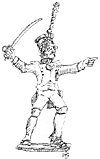 First Brigade makes First Contact
First Brigade makes First Contact
One hour later, both brigades were well on their way to Plancenoit. [See map 1]. The 5th dragoons led the First Brigade. Traveling at a canter along the road, three horsemen abreast and von Gabel himself at the front, the column came to a sudden stop as the sight of an entire battalion of French light infantry, drawn up in a line blocking the road. Thinking quickly, the cavalry commander ordered his regiment to form line. The dragoons were just out of effective musket range and had nearly formed the line when the French moved forward. Von Gabel saw several saddles emptied and a few horses down before he even heard the noise of five hundred muskets firing in unison. “First squadron,” he yelled. “Draw sabers. FORWARD!!!!!” The first squadron moved out, leaving a dozen dragoons dismounted, wounded, dead. The other squadrons continued forming into squadron lines, anticipating joining the fight in moments.
The French battalion commander had no time to form square. He would have to meet the dragoons in line. “Reload! Then fix bayonets.” Fortunately, his battalion was wider than the approaching dragoons. Furiously yet steadily, the French infantry rammed down powder and ball, primed pans, and then attached bayonets. As his men signaled their readiness by carrying their weapons in the ‘on guard’ position, their battalion commander ordered “Ready. Aim. Fire!” Hardly had the triggers been pulled when the horsemen made contact. Some places the horses stopped a few feet before the line of bayonets. In others, the frightened horses carried their riders through the three-man deep lines. Sabres flashed downward. Infantry cried in shock and pain. Within seconds, the once intact French line was a jumble of foot soldiers, horses, riders, bayonets and swords. Some dragoons who had penetrated the line turned, reformed, and moved back into the fray.
“Fall back!” Ordered the French commander. Obediently his survivors kept facing the main body of Prussians while steadily backing up, dressing their lines all the while, leaving dozens of wounded and dead behind. The Prussian First Squadron was spread out all over the place. As officers rapidly rallied the troops, the Second Squadron tried to force their way forward to get into contact with the French. The third and last squadron was still in the act of forming up in line. It was a mess. But the action would continue – von Gabel throwing squadron after squadron at the French who would get a single volley off before making contact with cold steel. Eventually ground down to nothingness, the French infantry, their battalion commander down, withdrew from the fight. The Fifth Dragoons cleared the road and reformed while von Gabel led the First Dragoons onward toward Plancenoit, still an hour or more away.
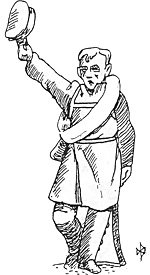 Meanwhile, along Second Brigade’s Advance
Meanwhile, along Second Brigade’s Advance
Colonel Bielakowski with the the 6th Hussars heard the musketry to the north as his long column skirted the southern edge of the Bois de Paris. The small village of Aywiers had just come into view when his eyes caught the flash of light from a hill rising beyond the Belgian village. Horses reared as cannon shot swooshed above the column. “Witten!” Bielakowski yelled for his First Squadron commander. “Assault the battery immediately. I’ll bring up the rest in support.” Witten saluted while turning his horse toward his hussars who were getting their horses back under control. In seconds the First Squadron was trotting down toward the overflowing creek. The low creek bed actually concealed the Prussian cavalry from view.
Hurredly the troops crossed and gingerly climbed the opposite bank. Witten led his men into the village where they would continue to enjoy concealment. The next blast of French cannon was directed at the remainder of the hussars north of the Lasne Creek as they attempted to form up. Leading about 200 troopers out of Aywiers, Witten formed on line and ordered his men to draw sabers. The French battery commander saw the flashes as the sabers caught the afternoon sun. He saw the ornate green pelisses and the uniformly black horses. “Re-direct your fire at the cavalry. Load grape!”
Witten’s squadron was into a gallop now, the line formation broken as the horses climbed the gentle slope, avoiding the few trees and boulders. The six flashes and the crash of cannon preceded the storm of grape shot penetrating the hussar line. Saddles emptied, horses loudly neighed and fell, throwing their unlucky riders. But the better part of the hussars closed with the gunners who defended themselves with swords and rammers. It was over in a minute. Those French artillerists who did not surrender were dead or seriously wounded. Seeing the results from his vantage north of the Lasne, Bielakowski recalled the second and third squadrons and ordered them to resume the column formation facing Plancenoit. The French battery interrupted their movement and cost them 15 minutes already. Looking back toward Aywiers, Bielakowski saw the flank guard, the dark blue uniforms of the 21st Infantry Regiment, pouring out of the woods and into the village. He imagined the traffic jam as the First Squadron tried to rejoin the regiment north of the Lasne. Now, how quickly could the commander of hussars get his troops moving again?
The Prussian movement through the difficult terrain was accordion-like. In clear areas, the troops moved quickly. However, where the terrain was close and the paths deep in mud, the rate of advance slowed considerably. [See map 2.] In the north, the 5th dragoons collected their wounded and pulled north of the road to reorganize. The 1st dragoons arrived at the site of the skirmish and saw the remnants of the French battalion scattered over several acres. Seeing open land before him, von Gabel ordered the 1st dragoons to form up with three squadrons in column, each squadron in two-deep line. He waited for the horse battery to catch up and he saw the dense columns of the 9th infantry approaching his rear. The jaegers, the brigade’s flank guard, just erupted from the Paris woods. Waving to the jaegers, Gabel ordered the 1st Dragoons to advance.
Meanwhile, General von Knapp arrived at the crossroads between Aywiers and the Paris Woods. What confusion! Hussars were on both sides of the Lasne. He could see the 21st Regiment south of the Lasne, trying to pass through Aywiers but intermingled with hussars. The 12th regiment was closing fast on the crossroads which was still occupied by Bielakowski’s hussars. “Colonel Bielakowski! Clear the intersection. Get your troopers north of the road and let the infantry through. Then give me your report.” Bielakowski, still at a distance, had no trouble hearing Baron Knapp’s booming orders. He saluted smartly, gave his own orders, and set off to join the brigade commander.
Bulow had reason to be concerned, although reports of the fighting would be slow to reach him as he hurriedly gave orders to his remaining two brigade commanders. A single battalion of light infantry and a battery of French guns had thrown his columns into confusion and slowed their movement. And worse was about to confront his leading brigades. Three companies of the Second Battalion of the 13th Light Infantry were clambering up the western slopes of a low rise hill northeast of Plancenoit [checkpoint 13]. Two battalions of the French 19th Infantry were occupying positions in the woods east of Plancenoit where they could easily defend the constricted approaches to that small town. West of Plancenoit, more infantry and a column of French dragoons and yet another of lancers were heading east with orders to stop the Prussians cold. The fight was about to get a lot hotter.
On a Hill near Plancenoit
The small battalion of the 2/13th light Infantry appeared at the top of a low rise and immediately took the 1st and 5th Prussian Dragoons under long range musket fire. [See map 3.] General von Kautt, von Gabel the cavalryman, and Colonel Boehman who led the main body of the First Brigade, were conferring when the musketry erupted. Seeing that the French were a small body, von Kautt ordered his advance guard dragoons to clear the open area to allow Boehman to form up the two battalions of the 9th infantry to assault the hill. Gabel sent word to the horse battery to come forward and take the French under long range fire.
It took awhile for the First Battalion and the Fusilier Battalion of the 9th Prussian Infantry to form up so Colonel Boehman sent the First Battalion in as soon as they were properly formed. With bayonets fixed and with the six guns of the horse battery firing in support, the 1/9th proceeded in a dense column of companies directly up the hill. The three companies of French light infantry steadily loaded and fired, oblivious to the cannon shot whistling through their line. But before the Prussians could impact, the commander of the 2/13th ordered his men to withdraw and they rapidly abandoned the high ground, falling back several hundred yards. As Colonel Boehman rode to the top of the newly won hill, he passed the bodies of scores of Colberg Infantrymen who hadn’t fired a shot and hadn’t crossed bayonets with the enemy.
At the top of the high ground Boehman saw a disturbing sight. Arrayed in the low ground west of the hill was a fresh battalion of French infantry and a regiment of green-coated dragoons. He sent word for General von Kautt to join him. Over the next twenty minutes, Kautt, Boehman and Gabel brought their troops onto the hill, forming them up to attack these new French forces. Von Kautt sent for his jaeger commander, Lieutenant Colonel Gott, and ordered him to clear the woods immediately south of the First Brigade’s attack position. And Colonel Boehman sent a frantic message back to the Elbe landwehr to hurry forward with all speed. If they could break this unexpected French opposition, they would need more infantry to continue the assault onto Plancenoit itself.
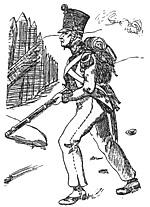 Confusion at Aywiers
Confusion at Aywiers
Meanwhile, the Second Brigade was running into troubles of its own. The battalion commander of the 1/21st Prussian Infantry surveyed his situation. He managed to get his troops moving westward through the hussars around Aywiers. The hussars were using the ford there to re-cross Lasne Creek. There were extensive woods on both sides of the Lasne but in order to best protect the flank of the Second Brigade, the 1/21st would have to be on the north side of that creek and clearing the woods between Lasne Creek and the road to Plancenoit. The battalion commander found a ford and ordered his companies into march column and across the creek. Once across, the lead company entered the long, narrow woods, ensuring that there were no French waiting in ambush. Slowly each company managed to cross the water obstacle and enter the woods.
The 12th Prussian Infantry was held up at the intersection until the hussars could get out of the way. The men enjoyed the break from the marching that had begun at dawn. Their commander, Colonel von Eggering, ordered the First Battalion to form into attack column – one company wide and four deep. In this formation Eggering led them westward. The remaining two battalions were still in march column spread out for miles. When the 1/12th arrived at the defile between the woods [south of check point 20] all hell broke loose. From their positions in the woods, three companies of the 2/19th French infantry poured a withering fire into the left flank of the Prussian attack column. The Prussians stopped cold as von Eggering ordered them to return fire while his trail company attempted to assault the ambushers in the wood line. But the ambush was much larger than von Eggering imagined. Thundering over a low hill to the west of the Prussians came a column of French lancers!
With buglers calling the charge, the French lancers drove in to the head of the Prussians. Prussian infantry fought back valiantly but gave ground steadily to the cavalry among them and the French infantry firing from the relative shelter of the wood line. Too many Prussian infantry were boxed in by their peers and unable to fight back. Fortunately for the Prussians, the jaegers in the woods [at check point 20] heard the sounds of battle and a few companies managed to work their way through the woods to the southern side where they could bring some firepower to bear on the French lancers. Picked off their horses by the close range rifle fire, the commander of the lancers finally ordered his bugler to sound the recall. Slowly breaking off the fight, the French lancers, now down to half their original strength, escaped down the road toward Plancenoit.
The 1/21st Prussian Infantry in the woods, hearing the fighting just to their west, redoubled their efforts to move through the trees. Eventually they came upon the half-battalion of the 2/19th firing at the Prussian column on the road to their front. The Prussians in the woods came on line and attacked westward, into the flank and rear of the 2/19th. Caught unawares, the French threw out a company to face the Prussian threat in the woods. Back and forth the fighting raged but slowly the French were forced westward in the woods. They no longer posed a threat to the 1/12th Prussian Infantry Battalion.
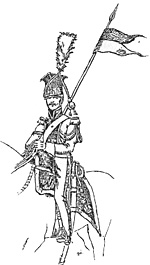 Von Bulow arrives on the Scene
Von Bulow arrives on the Scene
As General von Kautt, commander of First Brigade, was making final preparations to assault the French to his front, who should arrive but the corps commander himself. “Wilhelm, what is happening?” said von Bulow, unexpectedly using Kautt’s Christian name. “My general. As soon as the artillery company commanders signal their readiness, I will order Colonel Boehman to attack with two battalions. The 5th Dragoons will support on the right and Gott’s jaegers from the woods on the left.” Von Bulow nodded approvingly and examined the French line through his telescope. He saw a battalion of French on line with what appeared to be a small battalion of French light infantry behind them. Standing astride the road was a regiment or less of French dragoons. Catching the artillery battery commanders’ signals of readiness, von Kautt nodded at Boehman who in turn waved his two battalions forward. As the Prussian infantry marched down the slope, they uncovered their friends, the artillery gunners who opened fire with solid shot into the ranks of the French dragoons. A moment later, the jaegers broke out of the woods in skirmish formation heading for the high ground to their front [check point 14.] The battle was on.
With flags waving and drummers beating the cadence, the Prussian infantry conjured up visions of Frederick the Great’s prized infantry. The French defenders didn’t spend their time admiring the spectacle. With the precision derived from countless hours on the drill field, the French infantry raised their muskets. Firing by company, they kept up a steady blast of smoke and lead. The French dragoons were steadying their horses despite the numerous solid balls of iron hurtling through their ranks. When the Prussian fusilier battalion was only 150 yards away, the dragoon commander ordered his horsemen forward at the trot. In response to this new threat, the battalion commander of the fusiliers ordered his column to halt and form line. However, the Prussians were caught in the act of changing formation when the dragoons made impact. This did not, however, work to their disadvantage. The fierce Prussian fusiliers threw themselves on the dragoons and the fighting between saber and bayonet, dragoon and elite infantryman, was savage. Once the French dragoons lost the momentum of their charge, they were no longer at an advantage. Seeing frightful losses, the commander of the French dragoons ordered a withdrawal and his survivors happily complied, pulling back into Plancenoit itself. Many dragoons continued the withdrawal well westward.
The 1/9th Prussian infantry had similar results. [See map 4.] Taking significant casualties from the infantry on line to their front, the Prussians nonetheless advanced steadily. However, it was the impact of the 5th Prussian Dragoons on the left flank of the 1/19th French Infantry which proved decisive. Barely holding a semblance of formation, the French slowly yielded ground to the Prussian infantry column and accompanying dragoons. It was at this juncture, when the 1/9th Prussian infantry was pushing its attack forward into the French line, that the French got a break. The remnants of French lancers, hardly a troop, took advantage of the billowing clouds of smoke, to approach the gap between the two Prussian battalions. Attacking in to flank of the 1/9th, the lancers inflicted heavy casualties but within moments were themselves wiped out.
For their part, Gott’s jaegers performed magnificently. The French infantry in the woods immediately east of Plancenoit [three companies of the 2/19th French Infantry] opened fire at the Prussian skirmish line. Jaeger rifle fire accurately found Frenchmen who left the cover of trees or the concealment of bushes. French musket fire passed harmlessly through the very thin Prussian ranks. Gott saw the French ranks waver. He ordered his bugler to sound the advance. Other company buglers picked up the call and the anxious jaegers, in pairs and in squad groups, crashed into the woods. The French gave ground and tried to take their wounded with them. The fighting was without mercy and only the thinness of the Prussian ranks allowed as many of the French to withdraw as did.
In the Second Brigade area, the 1/12th Prussian Infantry steadily drove the remaining companies of the 2/19th into the very tip of the woods. Refusing to yield, the French were killed or captured to a man. However, as the Prussians emerged from the western end of the long, narrow woods, what did they see but a French battery astride the road backed up by an infantry force at battalion strength [the 3/19th Infantry.]
The 2nd and 3rd battalions of the 21st Infantry had been moving up rapidly on the south side of the Lasne. They had crossed at Aywiers when it became clear to the commander of the 2/21st that the road ahead was too clogged to permit rapid movement. This fortuitous decision now yielded results. The 2/21st emerged from the defile and saw the French drawn up astride the rood facing the 1/21st. Feeding companies into a firing line as they arrived, the battalion commander of the 2/21st poured escalating fire into the flanks of the 3/19th French infantry. Assailed by fire in front and flanks, the French slowly withdrew into Plancenoit.
Von Bulow was delighted with himself [although why is hard to tell]. The French had clearly delayed his two brigades despite their best tactical efforts. The Prussian corps commander helped von Kautt set up his attack that would crash into Plancenoit from the north. The Elbe landwehr had arrived and were even then forming up into attack columns. Von Bulow sent orders to Baron von Knapp to attack in the south with whatever troops were on hand when von Knapp heard the sounds of von Kautt’s attack. It was evident to von Bulow that Napoleon had taken the bait and was feeding even more troops into Plancenoit. He would not have been so happy to discover that a brigade of Young Guard was fortifying every house, every building of the town, prepared to prevent the Prussians from getting into the rear of the French Army of the North.
Conclusion
While I, acting as the Prussians, was frustrated by the results, I must admit this was a rollicking good game. Every time I thought I had cleared an obstacle, another French force was discovered in an advantageous position. I was constantly changing formations, from march column to attack column to line and back again. The dice were erratic as always, producing improbable results at the most inconvenient times. The terrain was constrictive enough to cause the Prussians to bunch up and to run out of maneuver room. Too often an asset, such as cavalry or a battery of guns, was left out of a fight because the terrain prohibited movement and maneuver. Many fights were evenly-matched infantry slug fests continuing for three or four turns until one side could force a decision.
For me, essentially a tactical commander in this game, the continuous fighting in several simultaneous skirmishes was entertaining. The entire flow of the game had gone pretty much as I had anticipated. The longer I took to move forward, the greater chance that more and more French troops would appear. As I suspected, the French had considerable strength in Plancenoit by the time the Prussians arrived in force. However, because of problems in scale (Plancenoit occupying less than a square foot of table top) I did not fight that battle. It was enough for me to shape the conditions of that battle.
If I had to do it all over again, I think I would add a movement corridor south of the Lasne or perhaps shift the battlefield further north. The tabletop south of Lasne Brook was under-utilized. Perhaps the addition of an ahistorical road through the woods between Maransart and Plancenoit would give the Prussians more options at approaching their goal. I also would tweak my morale rules. Too many formations fought on stubbornly or only backed up in the face of heavy casualties. But this was perhaps brought about because of too few opportunities for flank attacks or attacks in overwhelming strength.
Well, the itch to replay the Prussian approach to Plancenoit has been satisfactorily scratched for the time being. However, my youngest [age 14] was quite taken by the battle and the concept of play. He wanted to fight the French but I thought that would defeat the purpose of a solo game. So I think the next game will have the French positioned by chance but fought by a human. There is so much chance involved in where the French appear and in what composition, that no two battles should be similar. And if I open up a southern route to Plancenoit, well, the Prussian options have doubled. Okay, where is my master map? Let’s see, how will I do this?
Waterloo: The Paris Woods Scenario Part 2
Waterloo: The Paris Woods Scenario Part 1
Back to Table of Contents -- Lone Warrior # 148
Back to Lone Warrior List of Issues
Back to MagWeb Magazine List
© Copyright 2004 by Solo Wargamers Association.
This article appears in MagWeb.com (Magazine Web) on the Internet World Wide Web.
Other articles from military history and related magazines are available at http://www.magweb.com
